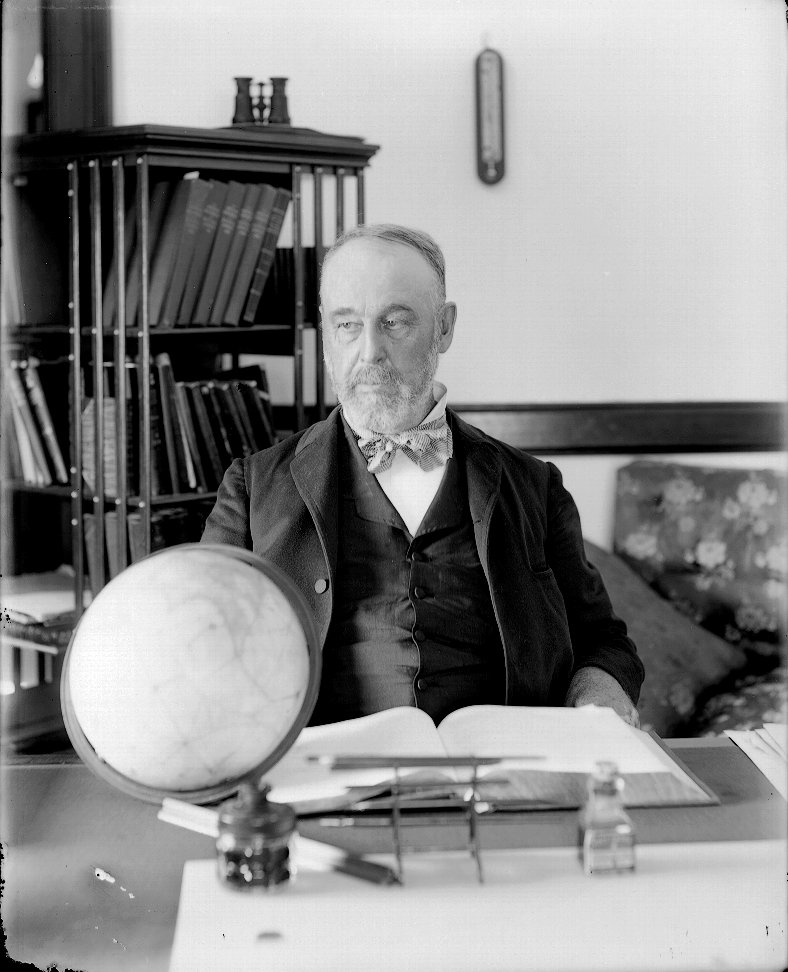AUGUST 9, 1996: The NEAT program based in Hawaii discovers an apparent asteroid, designated 1996 PW, that is found to be traveling in a near-parabolic comet-like orbit with an approximate orbital period of 5600 years. 1996 PW was the first known long-period “Damocloid,” and these objects are discussed in a future “Special Topics” presentation.
AUGUST 10, 1972: A tiny asteroid, probably somewhere between 10 and 20 meters in diameter, enters the earth’s atmosphere above Utah and, traveling almost due northward, passes within 60 km of Earth’s surface above Montana before returning to interplanetary space. This incident is discussed in more detail in a previous “Special Topics” presentation.
AUGUST 11, 2020: The main-belt asteroid (4151) Alanhale, which I have used as an illustrative example in several previous “Special Topics” presentations, will be at opposition. It is currently located in northeastern Capricornus and traveling towards the west-southwest, and is about 17th magnitude.
AUGUST 12, 1877: Asaph Hall at the U.S. Naval Observatory in Washington, D.C. discovers Mars’ smaller, outer moon, Deimos. Mars’ two moons, and the various small moons of the outer planets, are the subject of this week’s “Special Topics” presentation.

AUGUST 12, 1978: NASA’s International Sun-Earth Explorer 3 (ISEE-3) satellite is launched from Cape Canaveral, Florida. Originally part of a three-satellite international mission to study the interaction of the solar wind with Earth’s magnetosphere, ISEE-3 was based at the sun-Earth L1 Lagrangian point 1.6 million km sunward of Earth. After the completion of its original mission, in 1982 ISEE-3 was moved from L1 for a series of lunar flybys which propelled it – under the new name International Cometary Explorer (ICE) – to an encounter with Comet 21P/Giacobini-Zinner in 1985, becoming the first spacecraft to encounter a comet. The ISEE-3/ICE mission is discussed in a previous “Special Topics” presentation, and Comet 21P/Giacobini-Zinner is a future “Comet of the Week.”
AUGUST 12, 2020: The annual Perseid meteor shower is expected to be at its peak. Under favorable conditions, the Perseids can produce up to 100 meteors per hour, but the last-quarter moon will detract from the 2020 shower. The Perseids are associated with Comet 109P/Swift-Tuttle, which is a future “Comet of the Week,” and the association between comets and meteor showers, in general, is discussed in a future “Special Topics” presentation.
AUGUST 12, 2027: NASA’s Lucy mission, planned for launch in 2021, is scheduled to fly by the Jupiter Trojan asteroid (3548) Eurybates. The Lucy mission is discussed in a previous “Special Topics” presentation, and Trojan asteroids are the subject of a future “Special Topics” presentation.
AUGUST 13, 1898: Gustav Witt at the Berlin Observatory in Germany discovers the asteroid now known as (433) Eros; it was independently discovered the same night by Auguste Charlois at Nice Observatory in France. Eros was the first-known near-Earth asteroid and has passed relatively close to Earth on several occasions since then; it was orbited by the Near-Earth Asteroid Rendezvous (NEAR) Shoemaker spacecraft for one year in 2000-01 which then soft-landed onto Eros’ surface. Eros is the subject of a previous “Special Topics” presentation.
AUGUST 13, 1930: An apparent tiny asteroid enters the earth’s atmosphere above South America and explodes in an airburst above the surface near the Curuca River in far western Brazil. A Franciscan friar, Fedele d’Alviano, interviewed local witnesses to the event, but his report went unnoticed for the next six decades. Events of this nature are the subject of a previous “Special Topics” presentation.
AUGUST 13, 1994: Amateur astronomer Don Machholz in California discovers a comet, now known as Comet 141P/Machholz 2. The comet was accompanied by several “companion” comets, all but one of which soon disappeared, but the largest companion also appeared at the comet’s next return in 1999. Another dim companion accompanied the comet at its most recent return in 2015. Comet 141P returns to perihelion this coming December 20 under moderately favorable viewing circumstances, and it will be covered at the appropriate time in the Comet Resource Center.
AUGUST 13, 2013: Karen Meech and Olivier Hainaut obtain the final – to date – images of Comet Hale-Bopp C/1995 O1 with the European Southern Observatory’s Very Large Telescope in Chile; the comet’s heliocentric distance was 36.4 AU, the largest distance at which any comet has ever been detected. Comet Hale-Bopp was a previous “Comet of the Week.”
AUGUST 13, 2015: Comet 67P/Churyumov-Gerasimenko passes through perihelion at a heliocentric distance of 1.243 AU. Comet 67P was last week’s “Comet of the Week” and this return is the one during which it was visited by ESA’s Rosetta mission; various elements and results of this mission are discussed in last week’s Presentation.
AUGUST 14, 1992: A stony meteoroid enters the atmosphere and breaks apart near Mbale, Uganda. Several meteorite fragments reach the ground, and one of these, after its fall was broken by branches of a banana tree, hits a boy in the head (although, fortunately, causing no injuries). Meteorite falls of this nature are discussed in a previous “Special Topics” presentation.
AUGUST 14, 2014: A team of scientists led by Rhonda Stroud and Andrew Westphal announces that they have located what appear to be dust grains from interstellar space in samples returned to Earth by the Stardust spacecraft following its collection flyby of Comet 81P/Wild 2 – the Week 1 “Comet of the Week” – in 2004. The Stardust mission is discussed in a previous “Special Topics” presentation, and dust in the solar system is the subject of a future “Special Topics” presentation.
AUGUST 15, 2018: Pluto occults a 13th-magnitude star in Sagittarius, an event which is successfully observed from the U.S. and Mexico. Despite Pluto’s being almost three decades past perihelion passage, the occultation reveals that it is still accompanied by a thin atmosphere. Pluto is discussed in a previous “Special Topics” presentation.
More from Week 33:
Comet of the Week Special Topic Free PDF Download Glossary
Ice and Stone 2020 Home Page


